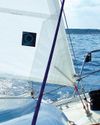Fitting a new water tank gauge
Practical Boat Owner
|Summer 2021
Measuring your boat’s water capacity is essential for any cruiser, yet is surprisingly hard to get right, discovers Roger Hughes

Boats are likely to have many instruments aboard, and one of the most useful is that which indicates the exact amount of fresh water in the tanks, especially if the boat doesn’t have a watermaker. But accurate water gauge reading has been a problem on every yacht I have owned.
My 45ft schooner Britannia has two stainless steel fresh water tanks amidships, one on each side. Like most yachts the outer shape follows the curve of the hull and the tanks are therefore broadly triangular-shaped in cross-section, tapering to a point at the bottom.

This shape makes accurate calibration of water capacity difficult for most electronic measuring devices: when the device in the tank measures the water halfway down the vertical side of the tank, the actual capacity is much less than half – only about a third in Britannia’s case.
The remedy would have been quite simple, if somewhat crude, had my system actually worked. It would have just been a question of first determining the exact volume of water in the tanks by draining and refilling, using a flow meter. Then divide the total by four to give one-quarter, half, three-quarters and full. Then refill one quarter at a time, marking the gauge accordingly.
The original system was – note the past tense here – pneumatic (air) operated, which works on the pressure differential as the water level in the tanks varies. It is a simple concept having only two components, and no electrics other than illumination of the gauge. Just the job for a cruising yacht you might think.
Denne historien er fra Summer 2021-utgaven av Practical Boat Owner.
Abonner på Magzter GOLD for å få tilgang til tusenvis av kuraterte premiumhistorier og over 9000 magasiner og aviser.
Allerede abonnent? Logg på
FLERE HISTORIER FRA Practical Boat Owner

Practical Boat Owner
An adventure to St Kilda
Marsali Taylor swaps skippering her Offshore 8m for being crew on a converted herring drifter, with comfy berths in the former fish hold
8 mins
January 2026

Practical Boat Owner
Mast refit and upgrade
Nicholas Koligiannis explains how he improved the mast on his Albin Ballad
5 mins
January 2026

Practical Boat Owner
Making more noise in fog
Nick Tyler takes the guesswork out of broadcasting fog signals
3 mins
January 2026

Practical Boat Owner
Solo across the Pacific
Triple amputee Craig Wood sailed into the history books with a non-stop, 90-day, 7,506-mile unassisted voyage
8 mins
January 2026
Practical Boat Owner
Al-assisted Shipping Forecasts
The Met Office has released new data showing a decade of steady improvement in the UK Shipping Forecast, with wind speed and sea state accuracy up by 10% or more.
1 min
January 2026

Practical Boat Owner
Bligh-ted reputation
Making the case for the mutiny on the Bounty's much maligned Captain Bligh
3 mins
January 2026

Practical Boat Owner
Wiper motor repair
Richard Stone mends his deck saloon windscreen wipers
2 mins
January 2026

Practical Boat Owner
'Let someone know boat plans' says report into fatal man overboard incident
The importance of designating a shore contact before setting off on a boat trip has been highlighted following a fatal man overboard incident near Inishbofin, Co. Galway, Ireland.
1 mins
January 2026

Practical Boat Owner
LITHIUM BATTERIES latest safety advice
Marine engineer and surveyor Marcus Jones unpicks the confusion surrounding the use of lithium batteries and what you should consider if installing them on board your boat
8 mins
January 2026

Practical Boat Owner
How to winterise your motor boat
Jon Mendez explains the steps you need to take to ensure your boat stays in top condition for next season
4 mins
January 2026
Translate
Change font size

